5 Backyard Solutions to Climate Change
If climate change has you feeling overwhelmed…confused…helpless…maybe even a little scared, I’m with you. The problem seems so big and complex.
You might wonder, Is there really anything that we can do that will make a difference?
Yes! And our gardens are a great place to start. The small steps we take at home have a ripple effect and move us toward living more sustainably as a culture, nation, and global community.
Colby and I have been inspired and encouraged lately by the work of Greta Thunberg and millions of others who are standing up to say, “Let’s DO something and take action on climate change!”
If you’re ready to take action, this video and post will give you five ideas for homegrown solutions to climate change.
At the end, tell me in the comments: What do you think it would take to have veggie gardens and compost bins take the place of lawns and trash bins in your neighborhood? And what other ideas do you have for sustainable and regenerative living?
Climate change is a complex issue, but comes down to two main problems.
First, we have an increasing amount of carbon dioxide and other greenhouse gases in the atmosphere. We pulled this carbon from underground where it was stored as fossil fuels. We burned the fuels and released the CO2 into the atmosphere. This causes the ‘greenhouse effect’ trapping more solar radiation (heat) and changing our climate.
Second, humans have damaged and developed many natural areas, which are part of the carbon cycle and help buffer the excess atmospheric carbon. We’ve cleared forests and prairies. We’ve tilled soil and killed the fungi and bacteria living underground. All living things are made of carbon, and all act as carbon sinks, especially the plants and soil life. Today, we have fewer places where carbon is naturally stored.
An Easy Way to Know What Helps
With this in mind, we can be confident we are slowing climate change when we do one of two things.
The first one is to use less fossil fuel energy and the second is to encourage the living things where carbon is stored. By growing plants and tending your soil, you are going to be doing both of these things.
Let’s take a deeper look at five specific ways we can address climate change in our own backyards.
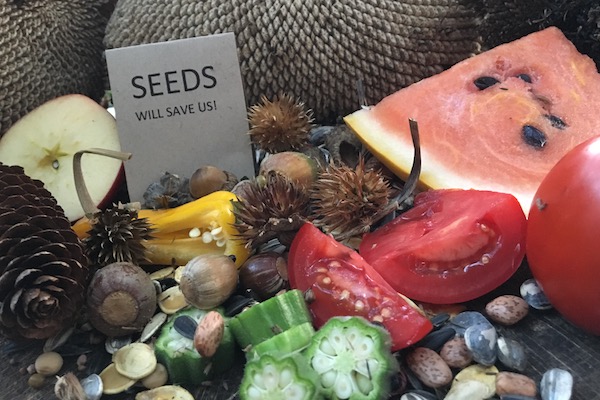
1. Grow Food
The best place to begin is with a veggie garden! My guess is you are already growing food (or you want to start your first garden) because here you are on a gardening website.
Great job! This really does make a difference.
Even if you have a small garden, you are helping in several different ways:
Your home garden, especially an organic one, uses less energy than a massive farm with its fossil-fuel-based machines, herbicides, and pesticides
Your plants are pulling atmospheric carbon into their parts and into the soil to feed the microbes
And last but not least, when you grow your own, you’re less dependent on food that comes from the grocery store. Your garden-fresh foods use much less energy than foods that need to be transported and refrigerated.
You have more awareness about local and seasonal foods. For example, you know that asparagus is one of the first things up in spring. That’s the time to eat it (and when it tastes best!) so you are less likely to purchase asparagus out of season. These buying decisions change our food system over time.
Even when it’s not our own food, we can choose to eat locally and in season and save tons and tons of carbon because we’re not shipping things across countless miles so that we can eat asparagus in late summer.
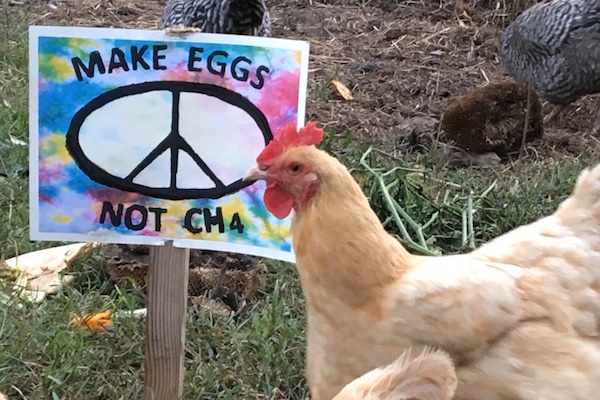
2. Turn Food Waste into Eggs
Food waste is a major problem, especially here in the United States. Most food has lots of carbon embedded in it. We’ve used fossil fuels to produce it, ship it across the country (or globe), and store it. To have that food go to waste is tragic.
Then, we put it in garbage bags to send it off to the landfill where it breaks down in an anaerobic situation (no oxygen in a landfill) and produces methane. While some landfills are able to capture that methane and use it for energy, some methane escapes and it’s another one of our greenhouse gases.
We don’t want to have food waste going off to the landfill. Instead, feed chickens with these leftover foods. In return for your scraps, they’ll fertilize your garden and provide you with delicious eggs. Once you’ve tasted homegrown eggs, it’s very hard to go back.
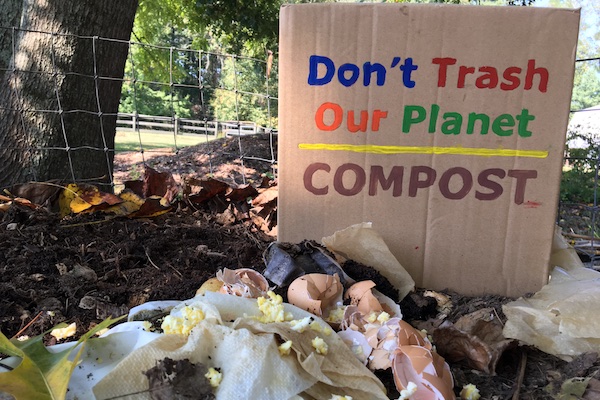
3. Recycle Yard Waste by Composting
Did you know that 30-50% of the trash in our landfills is organic waste? This waste will decompose if we choose to compost instead of bagging it up in plastic bags, hauling it to the curb, having dump trucks haul it to the landfill where it has that same off-gassing methane problem we talked about with food waste.
Recycle your yard waste at home by composting! Any kind of organic waste, including garden waste, leaves, branches, and paper waste, will decompose. Keep them on site and recycle them back into organic matter for your garden by composting.
You can also put your food waste into your compost pile, if you don’t have chickens! Or if you do have chickens, their bedding and manure can feed your compost pile.
This compost is a great, stable way to store carbon. The organic matter is going to make your soil healthier by feeding the life in your soil. And those living things are going to be storing carbon in your backyard, too.
Healthy soil means healthy plants, which also means you can grow even more food next season!
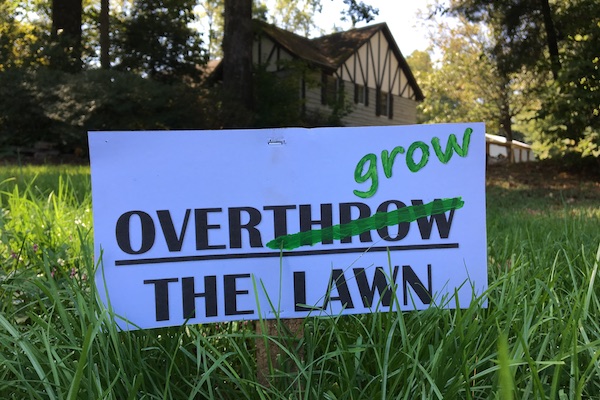
4. Overthrow Your Lawn
We have 40 million acres of lawns in the United States. Do we really need 40 million acres of lawns? Gotta keep them looking good, so we’re running gas-powered mowers, which are less efficient than most cars. One hour on the mower is equivalent to 10-12 hours in a typical car when it comes to carbon emissions.
What if we had fewer areas to mow?
What if we mowed less often?
What if we stopped mowing altogether?
We can overthrow or overgrow the lawn!
We’ve started overgrowing the lawn by expanding our garden beds. We’ve got mini-meadows and in the orchard, we’ve got a cover crop on the ground instead of just grass. It will grow up, become mulch, and we will only need to mow once a year. (Or bring over the chickens…in which case, we might not need to mow it at all!)
The mini-meadow gets mowed once a year – that’s a lot less then the weekly mowing the lawn takes. Consider letting part of your yard grow up and adding wildflowers to it. Put a nice fence around it and a a wildlife habitat sign to spread the idea to anyone walking by!
Sure, lawns are nice for kids and pets. But do we need 40 million acres of loans?
I propose that we need 30 million acres of fruit trees and wildlife habitat and pollinator flowers and gardens…and just 10 million acres of lawns. Or even less!
How can you shrink the lawn that you have to mow and increase the amount of space that you’re growing perennials and your garden beds?
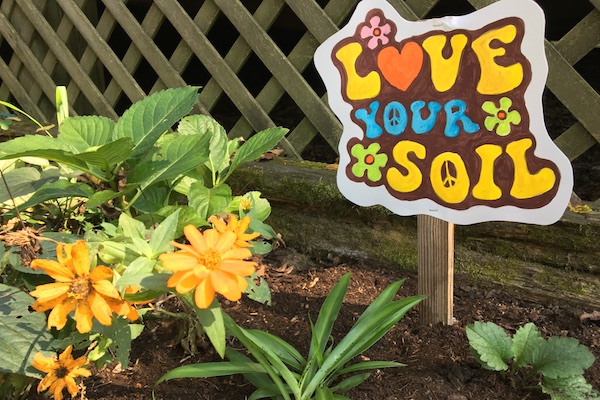
5. Love Your Soil
Ah, the soil below our feet. love your soil. Sometimes we think of it as dirt. Sometimes we don’t think of it all. But healthy soil is full of life.. All those living organisms—bacteria, fungi, worms, and more—are made of carbon.
Just look at fungi alone. Healthy soil has miles and miles of root-like fungal mycelium…miles and miles of carbon sequestering organisms.
When we till the soil or douse it with chemical fertilizers, pesticides, or herbicides, we kill off that life in our soil and release that carbon dioxide back into the air.
We want to keep that carbon down in the soil stored in the bodies of all these organisms. Low-till and no-till gardening, cover crops, and mulching are all ways to support the life in your soil. It will be storing carbon underground and producing delicious food for you at the same time.
For more ideas about soil, check out these seven healthy soil habits you can practice in your own yard.
Now, I’d love to hear from you!
These five ideas are just the beginning! Let’s chat in the comments below.
What actions are you taking and your own home and your own yard to live more sustainably and regeneratively?
What else should we be talking about when we talk about climate change?
What do you think it would take to have veggie gardens and compost bins take the place of lawns and trash bins in your neighborhood?

I’m Bev and like growing Vegs, fruit trees, and recently exploring the world of herbs. Imwoould like to learn more about creating healthier soil without heavy work because I have a back “challenge”..I’m trying to start new small beds in desert soil.
I’ve been composting for about 18 months. All our food scraps and yard waste, plus whatever I can get from our church. My neighbor with a large lawn gives me his yard waste and grass clippings. I rake the leaves from a nearby park and chop them up for mulch. Now that growing season is over, I’ve cut up the vegetable plants and left them on the garden beds as mulch. We’re converting half of our front bed from gravel and decorative bushes to Saskatoon bushes soil and mulched with organic matter. The other half is strawberries and perennial flowers. Back yard’s ornamental shrubs are being replaced with raspberries. I put in a keyhole garden this spring and plan to put in two more next year. We plan to gradually replace the lawn as we are able to accumulate more mulch. Also, we have eleven large trees that we want to remove, grins down to wood chips, and replace with fruit trees.
Hi Amy
We encourage as much wild life as possible into our garden by not spraying pesticides so encouraging predators to eat the “baddies”.Our little barrel pond is so helpful for the birds to drink and bath also the frogs that eat slugs! On our allotment site i cut the grass and use the cuttings as a mulch between the potato rows and compost the remaining to be used to dig in to our plot when needed,all the allotments weeds and top growth waste is also composted along with card board and any pigeon waste we can obtain.We use blood fish and bone meal to feed.We live in Dronfield in England
i like those tips i think they are helpful